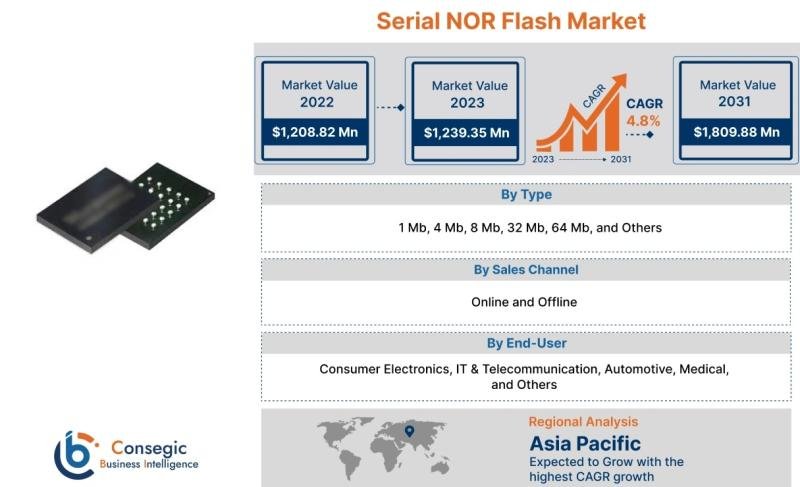Serial NOR Flash Market Introduction:
The Serial NOR Flash market centers around non-volatile memory chips that utilize a serial interface (such as SPI, Quad SPI, or Octal SPI) for data access. NOR Flash memory is characterized by its ability to allow random access for read operations, making it particularly suitable for code storage and execution (Execute-in-Place or XIP). The “serial” aspect refers to the way data is transferred to and from the chip, typically using fewer pins compared to parallel NOR Flash, leading to smaller package sizes, lower pin counts, and reduced system costs.
Request Free Sample Report (PDF): https://www.consegicbusinessintelligence.com/request-sample/1325
Serial NOR Flash has become a ubiquitous memory solution in a wide array of electronic devices, including automotive systems (for storing boot code and firmware), industrial control systems, medical devices, consumer electronics (like wearables and smart home devices), and telecommunications equipment. Its reliability, relatively fast read speeds, and non-volatility make it a critical component for storing and executing essential software and configuration data in embedded systems. The market continues to evolve with advancements in density, speed, and power efficiency to meet the growing demands of diverse applications.
Serial NOR Flash Market Size:
Global Serial NOR Flash Market Size is estimated to reach over USD 1,809.88 Million by 2031 from a value of USD 1,208.82 Million in 2022 and is projected to grow by USD 1,239.35 Million in 2023, growing at a CAGR of 4.8% from 2023 to 2031.
Serial NOR Flash Market Major Driving Factors and Opportunities:
Several key factors are propelling the growth of the serial NOR Flash market in 2025. Firstly, the increasing complexity of embedded systems and the growing amount of firmware and boot code required in various electronic devices are driving higher density requirements for NOR Flash. Applications like advanced driver-assistance systems (ADAS) in automobiles, sophisticated industrial controllers, and feature-rich consumer electronics necessitate larger and more reliable storage for their core software.
Secondly, the trend towards smaller form factors and lower pin counts in electronic devices favors serial interfaces over parallel interfaces, making Serial NOR Flash an ideal choice for space-constrained applications. Thirdly, the demand for faster boot times and quicker system responsiveness in many embedded systems is driving the adoption of higher-speed serial interfaces like Quad SPI (QSPI) and Octal SPI (OSPI), leading to increased performance of Serial NOR Flash.
The market also presents significant opportunities. The expanding automotive sector, with its increasing reliance on electronic control units (ECUs) and complex software for safety, infotainment, and autonomous driving features, represents a substantial growth area for high-reliability Serial NOR Flash.
Similarly, the burgeoning industrial IoT (IIoT) market, with its vast network of connected devices requiring local code storage and over-the-air (OTA) updates, is creating significant demand. The growing adoption of wearable electronics and other small, power-sensitive devices also presents opportunities for low-power Serial NOR Flash solutions. Furthermore, the increasing need for secure storage of boot code and critical data in connected devices is driving demand for Serial NOR Flash with enhanced security features.
Request Discount: https://www.consegicbusinessintelligence.com/request-discount/1325
Serial NOR Flash Market Scope:
The scope of the serial NOR Flash market encompasses various non-volatile memory chips that communicate using a serial interface. This includes:
SPI NOR Flash: Utilizing the Serial Peripheral Interface (SPI), offering a balance of simplicity and performance.
Quad SPI (QSPI) NOR Flash: Enhancing data transfer rates by using four data lines, providing significantly faster read and write performance compared to standard SPI.
Octal SPI (OSPI) NOR Flash: Further increasing performance by employing eight data lines, enabling even higher throughput for demanding applications.
Density Range: Covering a wide range of densities from a few megabits (Mb) to several gigabits (Gb), catering to diverse application needs.
Voltage Range: Offering different voltage options to suit various power requirements of embedded systems.
Temperature Grades: Including industrial and automotive grades with extended temperature operating ranges for harsh environments.
Package Types: Available in various compact surface-mount packages to accommodate different board space constraints.
The market scope also includes the associated software and tools for programming and managing these memory devices. The applications span a wide range of industries globally.
By Now: https://www.consegicbusinessintelligence.com/secure-checkout/1325
Serial NOR Flash Market Key Market Trends:
Several key trends are shaping the serial NOR Flash market in 2025:
Increasing Adoption of QSPI and OSPI: The demand for higher performance is driving a significant shift towards QSPI and OSPI interfaces, which offer much faster read and write speeds compared to traditional SPI. This trend is particularly evident in automotive, industrial, and high-performance consumer electronics.
Higher Density Offerings: As embedded systems become more complex and require larger code bases and data storage, manufacturers are continuously releasing Serial NOR Flash devices with higher densities. Densities are now commonly reaching into the Gigabit range.
Focus on Low Power Consumption: For battery-powered devices and energy-efficient systems, low power consumption is a critical requirement. Serial NOR Flash vendors are innovating to reduce active and standby power consumption.
Enhanced Security Features: With the increasing connectivity of devices, security is paramount. Serial NOR Flash devices are incorporating features like secure boot, hardware root of trust, and protection against unauthorized access and modification.
Smaller Footprint Packages: The trend towards miniaturization in electronic devices is driving demand for Serial NOR Flash in smaller and thinner packages, such as WSON and USON.
Stringent Reliability and Quality Requirements: Especially in automotive and industrial applications, high reliability and long-term data retention are crucial. Serial NOR Flash manufacturers are focusing on meeting stringent quality standards like AEC-Q100.
Support for Over-the-Air (OTA) Updates: The ability to update firmware remotely is becoming increasingly important for many connected devices. Serial NOR Flash devices are being designed to support efficient and reliable OTA update processes.
Serial NOR Flash Market Key Players:
The serial NOR Flash market in 2025 is characterized by a mix of large, established memory manufacturers and some specialized players. Some of the key players include:
Microchip Technology Inc.
Macronix International Co. Ltd.
Microchip Technology Inc.
KIOXIA Holdings Corporation
Renesas Electronics Corporation
Infineon Technologies AG
Toshiba Corporation
SK Hynix Inc.
Intel Corporation
Infineon Technologies AG
The competitive landscape is dynamic, with companies focusing on product innovation, cost competitiveness, and expanding their application reach to gain market share.
Sample Report: https://www.consegicbusinessintelligence.com/request-sample/1325
Serial NOR Flash Market Segmentation:
The serial NOR Flash market in 2025 can be segmented based on several factors:
Based on the Type: 1 Mb, 4 Mb, 8 Mb, 32 Mb, 64 Mb, and Others
Based on the Sales Channel: Online and Offline
Based on the End-User: Consumer Electronics, IT & Telecommunication, Automotive, Medical, and Others
Understanding these different segments is crucial for market analysis, identifying target markets, and developing effective business strategies.
Serial NOR Flash Market Opportunities and Challenges:
Opportunities:
Growth in Automotive Electronics: The increasing electronic content in vehicles, particularly for ADAS and autonomous driving, presents a significant and growing opportunity for high-reliability and high-performance Serial NOR Flash.
Expansion of Industrial IoT (IIoT): The proliferation of connected industrial devices requiring local code storage and OTA updates is driving demand for robust and secure Serial NOR Flash.
Increasing Adoption of Wearable Devices: The growing market for smartwatches, fitness trackers, and other wearables requires small, low-power, and reliable Serial NOR Flash for storing firmware and data.
Demand for Secure Boot and Firmware Storage: The rising concerns about cyber security are driving the need for Serial NOR Flash with enhanced security features to protect boot code and critical firmware.
Replacement of Parallel NOR Flash: In many new designs, Serial NOR Flash is preferred over parallel NOR Flash due to its lower pin count, smaller footprint, and comparable or even better performance with high-speed interfaces.
Challenges:
Competition from Other Memory Technologies: While Serial NOR Flash has its unique advantages, it faces competition from other non-volatile memory technologies like NAND Flash (for higher density storage) and emerging NVMs (for potential performance and power benefits in the future).
Pricing Pressure: The memory market can be price-sensitive, and Serial NOR Flash manufacturers face pressure to offer competitive pricing while maintaining profitability.
Meeting Stringent Reliability Requirements: Applications like automotive and industrial demand extremely high levels of reliability and endurance, which can be challenging to achieve consistently across all density and speed grades.
Ensuring Security Against Sophisticated Threats: As security features become more critical, manufacturers need to continuously innovate to protect against evolving cyber threats.
Managing Supply Chain Volatility: Fluctuations in the supply and demand of raw materials and components can impact the production and pricing of Serial NOR Flash.
Serial NOR Flash Market Regional Analysis:
The serial NOR Flash market in 2025 exhibits varying growth rates and characteristics across different regions:
Asia Pacific: Expected to be the largest and fastest-growing market. The region is a major hub for electronics manufacturing, particularly in automotive, industrial, and consumer electronics, driving significant demand for Serial NOR Flash. China, Japan, South Korea, and Taiwan are key markets.
North America: A significant market driven by strong adoption in automotive, industrial, and high-end consumer electronics. The presence of leading technology innovators also contributes to the demand for advanced Serial NOR Flash solutions.
Europe: A well-established market with a strong focus on automotive and industrial applications, demanding high-reliability and automotive-grade Serial NOR Flash. Germany is a particularly important market.
Rest of the World: The market in other regions is growing at a steady pace, driven by increasing electronics adoption and the development of local manufacturing capabilities.
Regional analysis helps to understand the specific application demands, regulatory landscapes, and growth opportunities in different parts of the world, allowing manufacturers to tailor their strategies accordingly.
Serial NOR Flash Market Recent Developments:
The serial NOR Flash market as of April 2025 is characterized by several recent developments:
Introduction of Higher Density OSPI Solutions: Manufacturers are increasingly launching Serial NOR Flash devices with densities exceeding 1 Gb, utilizing the high-speed OSPI interface to address the growing code storage requirements in advanced applications.
Enhanced Security Features in New Products: Recent product releases are incorporating more advanced security features, such as secure boot with hardware root of trust, in-line encryption, and enhanced protection against physical attacks.
Focus on Lower Power Consumption for Mobile and IoT: New generations of Serial NOR Flash are being optimized for ultra-low power consumption to extend battery life in mobile and IoT devices.
Development of Smaller Package Options: Manufacturers continue to innovate in packaging technology, offering smaller and thinner form factors to meet the space constraints of modern electronic devices.
Increased Availability of Automotive-Grade QSPI and OSPI Devices: To cater to the growing demand in the automotive sector, more high-speed (QSPI and OSPI) Serial NOR Flash devices are being released with automotive-grade certifications (AEC-Q100).
Integration of Advanced Error Correction Codes (ECC): To ensure data reliability, especially at higher densities and in harsh environments, newer Serial NOR Flash devices are incorporating more sophisticated ECC algorithms.
Strategic Partnerships and Collaborations: Collaborations between Serial NOR Flash vendors and microcontroller/SoC manufacturers are increasing to optimize memory solutions for specific platforms and applications.
Contact Us:
Consegic Business intelligence Pvt Ltd.
B 202 , 2nd Floor, Ujwal Serene, Baner Road, Baner, Pune, Maharashtra – 411045.
Contact No: (US) (505) 715-4344
Email: sales@consegicbusinessintelligence.com
About Us: At Consegic Business Intelligence Pvt. Ltd., we empower businesses with actionable insights and innovative market intelligence solutions. Our tailored research and data-driven strategies help organizations navigate complex industry landscapes and make confident decisions.
This release was published on openPR.

















